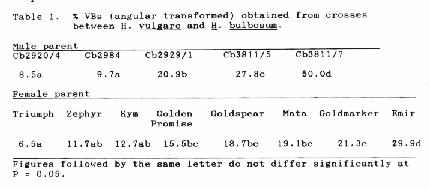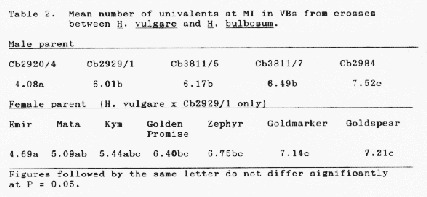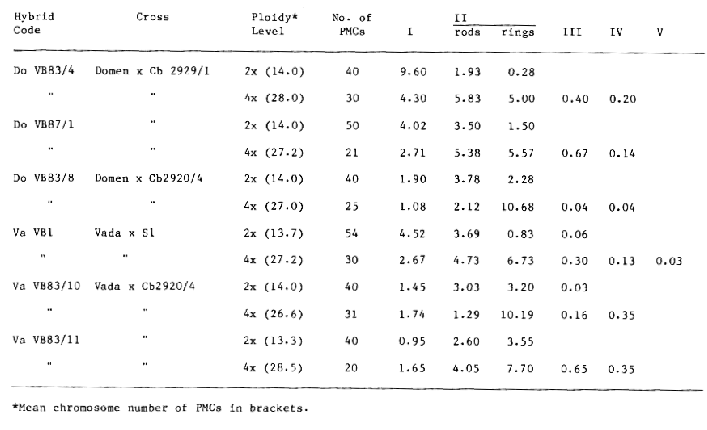

The interspecific hybridization programme at DSIR aims to transfer desirable characters, mainly disease resistance, from H. bulbosum (2n = 2x = 14) to H. vulgare. The former species was chosen partly because of its close taxonomic relationship with H. vulgare (von Bothmer et al., 1983) and partly for its resistance to the major fungal pathogens in New Zealand (powdery mildew- Erysiphe graminis f. sp. hordei; scald Rhychosporium secalis; leaf rust - Puccinia hordei; net blotch Dreschlera teres).
As it is known that temperature influences chromosome elimination in the developing embryo of crosses between barley and H. bulbosum (Pickering, 1985), H. vulgare was pollinated by diploid H. bulbosum in a controlled environment room (18 + 0.50C/14 + 0.50C; 18 h day/6 h night; light supplied by cool white fluorescent tubes with an irradiance of 380 E m-2-sec-1 at spike height) as well as in a cool glasshouse. This was to encourage the retention of the H. bulbosum chromosomes and increase the percentage of VB hybrids which combine one set of chromosomes from each parent.
At first, seven H. vulgare cultivars. (Emir, Goldmarket, Goldspear, Kym, Mata, Triumph and Zephyr) were crossed with each of seven diploid H. bulbosum genotypes (Cb2920/4, Cb2929/1, Cb2951/6, Cb2951/8, Eb2984, Cb3811/5, Cb3811/7). The latter were chosen from 16 genotypes on the basis of their good disease resistance. Because of the responsiveness of the cultivar Golden Promise to tissue culture techniques, we crossed this cultivar later with three of the H. bulbosum genotypes. Embryos were cultured on B5 medium without 2,4-D, and all haploid plantlets were discarded as seedlings. The aim was to produce six VB hybrids from each cross combination and identify cytologically the hybrids with a high level of pairing between the parental chromosomes. Two hundred and thirteen VB hybrids were grown in the controlled environment room and 25 pollen mother cells (PMCs) from each were analyzed at MI.
It was very difficult to obtain hybrids from Cb2951/6 and Cb2951/8 as pollinators, and only crosses between Emir and these two genotypes were successful in this respect. Regarding the remaining crosses there were significant differences between parents in the proportions of VBs produced (Table 1), although those from Triumph were usually weak and often died as seedlings. There were also significant differences between the H. bulbosum genotypes in the numbers of univalents at MI in the VBs, but apart from the crosses between H. vulgare and Cb2929/1 there were no significant differences between the barley cultivars in this respect (Table 2).


On the basis of the meiotic data we have selected 16 high pairing VBs with chiasmata/cell ranging from 5.72 to 9.04. These will be used both for anther culture and as parents once their fertility has been restored using colchicine to double their chromosome number. However, the latter course of action may be curtailed as there appears to be no marked relationship between the pairing in diploid VBs and multivalent formation in the fertile VVBB amphidiploids (Table 3 and Thomas, 1988).

Other problems have been encountered in attempts to double the chromosome number of the VB hybrids, namely, the difficulty of maintaining VVBB fertility following colchicine treatment of the VBs and the presence of fertile H. vulgare sectors in the VVBBs resulting from loss of H. bulbosum chromosomes. It has also been somewhat disappointing that the numbers of recombinants from selfed or crossed VVBBs has been extremely low and future work will b concentrated more on the fertile VBB hybrids described elsewhere in this volume of BGN. However, seed samples of four selections derived from the diploid crossing programmet which are resistant to disease in New Zealand, are available from the author.
References:
von Bothmer, R., J. Flink, N. Jacobsen, m. Kotimaki, and T. Landstrom. 1983. Interspecific hybridization with cultivated barley (Hordeum vulgare L.). Hereditas 99:219-244.
Pickering, R. A. 1985. Partial control of chromosome elimination by temperature in immature embryos of Hordeum vulgare L. × H. bulbosum L. Euphytica 34:869- 874.
Thomas, H. M. 1988. Chromosome elimination and chromosome pairing in tetraploid hybrids of Hordeum vulgare × H. bulbosum. Theor. Appl. Genet. (in press).